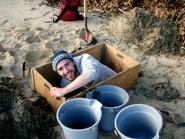
Daniel Feinberg '12 spent the fall semester as a student in the Semester in Environmental Science, in Woods Hole, Mass. The first Hamilton student to participate in the program, he has been measuring the lifetime of Permeable Reactive Barriers, relatively affordable systems that can remove nitrate pollution from groundwater. Here he describes his experience in the program.
I can think of no better place to study the natural world than Cape Cod, Mass., where I’ve spent this fall in oak, pine, and beech forests, coastal ponds, and beach-lined estuaries. I’m participating in the Semester in Environmental Science, a program run jointly by the Marine Biological Laboratory (MBL) and Brown University. MBL is located in Woods Hole, home to several scientific organizations including Woods Hole Oceanographic Institution, Woods Hole Research Center, and the U.S. Geological Survey.
My professors at MBL are “systems ecologists”; they study global environmental issues using methods in biology, geology, and chemistry. Their interests range from climate change in the Arctic and Antarctica, to deforestation in the Amazon, to overharvesting of the world’s fisheries. The students come from various liberal arts colleges within a consortium that includes Hamilton as well as other NESCAC schools such as Middlebury and Connecticut College.
The program consists of nine weeks of classes followed by six weeks of independent research. The core classes, terrestrial and aquatic ecology, are closely tied to field and lab work. There’s also a science writing seminar and an elective – I chose Mathematical Modeling of Ecosystems, an applied math class in which I built a computer model of wetland plant competition.
For my research project, I’m measuring the lifetime of Permeable Reactive Barriers, relatively affordable systems that can remove nitrate pollution from groundwater. They function by providing carbohydrates, in the form of wood chips, to bacteria that perform the chemical reaction of denitrification. This is significant because when groundwater contains excessive nitrate, the water can transport it to downstream ponds and estuaries, causing algal blooms that, in turn, prevent aquatic organisms from obtaining oxygen. I’m studying these barriers by collecting field samples and analyzing them in the lab. Other students are examining topics such as stream restoration, leaf decomposition, and microbial diversity. At the end of the semester, we will all present our research to the scientists in a symposium format.
I'm the first Hamilton student to participate in the Semester in Environmental Science, but I absolutely recommend it to anyone interested in learning how to solve environmental problems and how to plan for a more sustainable future. I look forward to returning to the Hill but I’m going to miss my semester in Woods Hole.
Posted December 5, 2010
